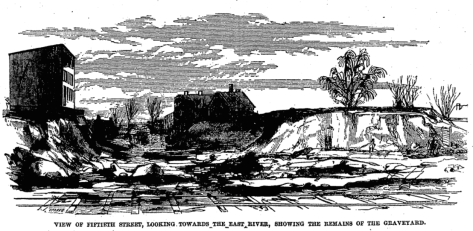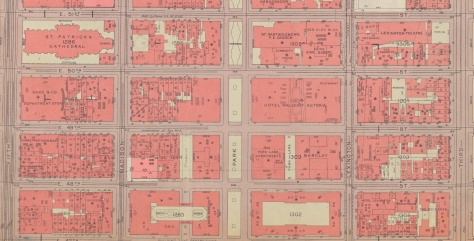
When New York City authorities decided to close the public burial ground at Washington Square in 1825, they selected a property “situate between the Third and Fourth Avenues, and between the 48th & 50th Streets” as the location for the new potter’s field. The site was considered well-suited for a public burial ground, since it was outside the populated city but only about a mile-and-a-half from both the state prison on the Hudson River and the almshouse at Bellevue. The grounds had recently been improved by the Commissioners of the Almshouse (who may have already been using it as burial ground), were enclosed by a “strong stone wall,” and required “no preparation for its immediate occupancy than that of a small tenement as a residence for the Keeper.” The site was quickly put into operation—the following year, 1,659 of the 4,973 people who died in the city were interred in the new potter’s field.
Located between today’s 50th and 48th streets and extending from Park to Lexington avenues, the remains of more than 60,000 people were laid to rest in the potter’s field over the next two decades, including approximately 600 cholera victims interred there during an outbreak in the summer of 1832. By the 1840s, the city was regularly receiving complaints about conditions at the 50th Street potter’s field. The New York Mirror called the site “disgraceful to the city of New-York—revolting to every proper feeling of the human heart, and unworthy of a Christian country.” In an 1845 report to the Board of Aldermen, the City Health Inspector described the situation at the site, where “bodies have not been regularly or decently interred in graves, but great pits have been dug in which a large number of bodies have been deposited; and when filled, have been covered over slightly with earth, allowing the most offensive and pernicious exhalations to fill the atmosphere, to such an extent as to endanger the health of the whole neighborhood.” Though a site on Randall’s Island was selected for a new potter’s field in 1843, many of the city’s indigent and unknown continued to be buried at the 50th Street site until the late 1840s.

During the 1850s, the defunct public burial ground at 50th Street was continually disturbed by the city’s northward expansion. A section of the grounds at Fourth Avenue (today’s Park Avenue) and 48th Street transferred to a private owner, necessitating the removal of some 2,000 bodies to another part of the field. Property owners in the vicinity petitioned the city to convert the site into a public park, as it had done with the previous public burial ground at Washington Square, but the request was refused by the city council, who voted to open 49th Street through the site. The city cut the street through in 1853, leaving “the bones of its unfortunate citizens” scattered about, according to the Evening Post.

Thousands of bodies were again disinterred and moved to another area of the grounds in 1857, when Fourth Avenue and 50th Street were graded along the site’s western and northern boundaries. This work left the old potter’s field in shambles—the Herald described stacks of coffins lining the sidewalks and a rough fence erected on the southwest corner of Fourth Avenue and 50th Street to “prevent the pile of coffins tumbling from their somewhat higher position to the level of the newly made sidewalk.” Exposed coffins were visible in the soil banks along the graded streets, “with the hairless skulls of the poor pauper occupants staring the passerby full in the face.”

In April 1857, the City Health Inspector recommended removal of remains from the 50th Street Potter’s Field, noting that the “general appearance of the ground was disgusting,” with hundreds of human bones exposed and “many people gathered there on Sundays and amused themselves by poking out the skulls and bones.” In 1858-59, the remains were disinterred and transferred to the potter’s field then in operation on Ward’s Island. The 50th Street potter’s field is notable as the last potter’s field established on Manhattan Island; much of the site is occupied today by the Waldorf-Astoria Hotel, built in 1929-31.


Sources: Colton’s 1836 Map Of The City and County Of New-York; Bromley’s 1955 Manhattan Land Book of the City of New York, Pl 78; Minutes of the Common Council of the City of New York, 1784-1831 (City of New York 1917), 14:306-308; “Proceedings of the Common Council,” New York Spectator, Mar 6, 1827; [City Inspector’s Report of Deaths], New York Evening Post Jul 17, 1832; “Board of Health,” New York Spectator, Jul 26, 1832; “Potter’s Field,” New York Mirror May 30 1840; Documents of the Board of Aldermen of the City of New York Vol 11, 1845, 681-682; “Burials in Cities,” New York Daily Tribune May 30, 1848; “Twelfth Ward Street Opening,” New York Herald, Mar 26, 1850; “Old Potter’s Field,” New York Evening Post, May 30, 1853; “The Old Potter’s Field,” New York Times, May 31, 1853; “The Old Potter’s Field,” New York Herald, Mar 15, 1857; “Public Health—Potter’s Field Again,” New York Daily Tribune, Apr 7, 1857; “Exhumation of Bodies at the Potter’s Field,” New York Evening Post, Jun 8, 1858; “Potter’s Field,” Frank Leslie’s Illustrated Newspaper, Jun 19, 1858; “The News,” New York Herald, Jun 7, 1859
